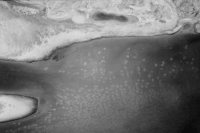Blog post by Theresa Labriola, Riverkeeper’s Hanford Coordinator—
This fall, the Columbia River featured the strongest fall Chinook salmon run since 1938, when counting began at Bonneville Dam. More than 950,000 adult fall Chinook traversed the Bonneville Dam and more than 450,000 crossed McNary Dam into the Hanford Reach of the Columbia River. McNary Dam is the southern boundary of the 51-mile Hanford Reach—the most productive spawning ground for wild fall Chinook on the Columbia River.

The Hanford Reach cradles the Hanford Nuclear Site, the most contaminated site in the western hemisphere. Each year, groundwater contaminated with Tritium, Chromium, Strontium 90, Uranium, Technetium 99, and Iodine 129 leaches into the River, and the wild Chinook salmon spawning ground.
Biologists say the historic return resulted from a perfect combination of abundant food, cool ocean temperatures, and dam improvements. Now mature, this year’s record run traveled in search of perfect spawning habitat—clear waters flowing over cobblestoned bottom.
The ongoing success of the Hanford Reach spawning ground and record returns depends on our continuing efforts to prevent nuclear pollution from entering the River. Thousands of Chinook will build spawning nests, or redds, in the Hanford Reach. The female, or hen, cleans the silt and algae off the gravel and cobbles while building her nest, leaving a characteristic white clearing the size of a Volkswagen.
Next year maybe you can cast your line into the Columbia River in search of a fall Chinook, or stop by the Bonneville Dam to watch them navigate the fish ladder? Maybe you’ll see a Chinook swimming towards the Hanford Reach?



